
Recently on Cyclingnews.com |
News feature, June 10, 2008
Does Dauphiné success guarantee Tour de France victory?
By Susan Westemeyer
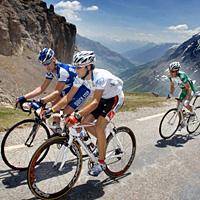
|
The Critérium du Dauphiné Libéré has long been considered the preparation race for the Tour de France. If you do well in the Dauphiné, you will do well in the the Tour, is how the theory goes. From looking at the last nine years is this a golden rule or just a rash assumption?
If your name is Lance Armstrong, then yes, you did well in both races. However few other riders have replicated their form in both races. Andrei Kivilev finished fifth in the Dauphiné and fourth in the Tour in 2001. Iban Mayo finished second and sixth in 2003. In 2005, Alexander Vinokourov finished fifth in both races. And last year, Cadel Evans was the runner-up in both, while Alberto Contador was sixth in the Dauphiné and yet went on to win La Grande Boucle.
Some Dauphiné winners went on to either crash out of the Tour (Christophe Moreau in 2001 and Iban Mayo in 2004). Others simply bombed once they got to the Tour (Vinokourov 1999, Iñigo Landaluze 2006). And some were so focused on the Dauphiné that they simply peaked too soon. (Iban Mayo 2003, Levi Leipheimer 2006)
Here is a year-by-year look at the 1999 to 2007 editions.
1999
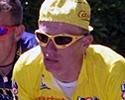
|
Rewind to 1999, and the cycling world watched in awe as a fresh-faced Kazakh by the name of Alexander Vinokourov became the surprise winner. A second year professional with the short-lived but highly entertaining Casino team, the 25 year-old turned out an exemplary performance in the mountains. Rather ironically, we labelled the Kazakh as 'part of a new generation of riders that provide a fresh image in the face of the doping scandals.' 'Vino' had already won a stage and the overall at the Volta a Valenciana, and two stages at the Midi Libre, all before his stage win and the overall at the Dauphiné.
Going into the Tour de France as a rank outsider, he finished a creditable 35th, but over an hour down. He fell back on the first time trial, when he lost over six minutes on the 56-kilometre course to Lance Armstrong.
That year Armstrong finished a creditable eighth in the Dauphiné but coming into the Tour as an unknown quantity he went on to dominate the race. He was not the best-placed US Postal rider in the Dauphiné though. Jonathan Vaughters finished second, with Kevin Livingston in sixth. In July Vaughters only made it to the second stage, when he had to drop out after falling victim to the mass crash on the Passage du Gois.
Results: Dauphiné Libéré versus Tour de France
2000
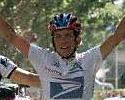
|
The Postal boys put their stamp firmly on the 2000 Dauphiné with Tyler Hamilton taking yellow and Armstrong playing the faithful lieutenant and finishing third. Hamilton took two stages on his way to victory, a mountaintop finish at Mont Ventoux and then the next stage into Digne-les-Bains, going over the finish line with Armstrong in tow.
Fast forward to July and the roles were reversed, with Hamilton returning to his familiar domestique role – undoubtedly one of the reasons for leaving US Postal – to finish as the second-best US Postal rider in 25th place.
Armstrong had used the race as the perfect warm-up, winning both the prologue and the time trial. And, as Cyclingnews pointed out at the time, "As part of the build up for a certain race next month, Armstrong has managed to keep his rivals at bay despite the fact that he is working for Hamilton."
Other Dauphine animators included second placed Haimar Zubeldia, whose Euskaltel-Euskadi team was not invited to the Tour de France. Fourth placed finisher Alex Zülle (Banesto) dropped out of the Tour's 17th stage, having fallen back in the Alps and lacking united team support. The fifth place finisher in the Dauphiné was former US Postal rider Vaughters, who had left the USA team in search of his own possibilities at Crédit Agricole, but a crash forced him out of the race early.
Results: Dauphiné Libéré versus Tour de France
2001

|
In the Dauphiné's closest finish ever, France's Christophe Moreau (Festina) took the win from Pavel Tonkov (Mercury) by just one second. He went on to win the prologue of the Tour de France, but a crash in the 12th stage forced him out, when he was in sixth place overall.
Tonkov's Mercury team was not invited to the Tour, and fourth placed Dauphiné finisher Sven Montgomery of La Française des Jeux crashed out in the 16th stage, while he was in 17th place overall. Benoit Salmon (Ag2R) had a promising Dauphiné – finishing third – but ended 35th in the Tour, 1'17" down.
The best finisher of the top five in the Tour was Kazakh rider Andrei Kivilev of Cofidis. He finished the Dauphiné in fifth, nearly four minutes down, and improved his position in Paris, where he was fourth overall, nearly ten minutes behind winner Lance Armstrong. He was the only one of the Tour's top five finishers to have ridden the Dauphiné that year.
Results: Dauphiné Libéré versus Tour de France
2002
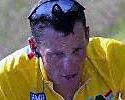
|
Having ridden and won the Tour de Suisse in 2001, Armstrong returned to the Dauphiné in 2002 and took his first overall victory. "Like every year, people will say that I'm ready too early but I have to say I feel very confident," he said. Once again, he went on to win the Tour.
Second place went to his new team-mate Floyd Landis, who would go on to captain another team and make his own Tour de France-related headlines within the next few years.
Unlike the previous year, all five of the top finishers went on to ride the Tour. As noted, Armstrong won, and his domestique Landis finished 61st, 1'48" down. Moreau crashed out of the Tour yet again, while Zubeldia and his Euskaltel-Euskadi team were finally invited to the Tour. He was the best of the Basque team, finishing 39th in Paris. Fifth place Dauphiné finisher Kivilev was only 21st, in what was to be his last Tour de France.
Of the other Tour top five finishers, only Santiago Botero – fourth at 13'10" – also rode the Dauphiné, where he won a stage and finished 38th overall.
Results: Dauphiné Libéré versus Tour de France
2003
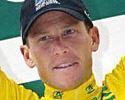
|
How much was the 2003 Dauphiné a sign of things to come for the Tour? That year Armstrong was put under serious pressure, primarily from runner-up Iban Mayo. He called it "The hardest Dauphiné Libéré I ever entered." During the race he won the time trial stage and crashed in stage five.
Come July, Mayo was again one of the USA rider's sternest rivals, blowing the race apart in the Alps and finishing sixth overall. David Millar, third in the Dauphiné, finished second in the Tour prologue, but won the 19th stage time trial. He ended up 55th, nearly two hours down. Francesco Mancebo went from fourth in the Dauphiné to 10th in the Tour. Moreau, fifth, finally made it to the end of the Tour, and finished eighth overall. Armstrong and Hamilton were the only top five Tour de France finishers to have ridden the Dauphiné.
Results: Dauphiné Libéré versus Tour de France
2004
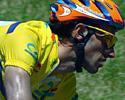
|
Mayo got his revenge this year, winning the Dauphiné over Armstrong. The two had battled it out the previous season, and Mayo was determined to win it this year. He did so, "with victory in the prologue, a resounding triumph on the slopes of the Mont Ventoux, and hardly a moment of weakness throughout the week." But he was unable to follow through in the Tour. Crashing on the Belgian cobblestones in stage three, he lost nearly four minutes and, demoralized, he lost 38 minutes in stage 13 before dropping out after the next stage. The general feeling was that he had peaked too early in the season.
Two Phonak riders finished second and third in the Dauphiné, Tyler Hamilton and Oscar Sevilla, but they didn't fare so well in the Tour. Hamilton pulled out at stage twelve, when he was forced out by a back injury. Sevilla finished 24th overall, 45 minutes behind the Tour winner.
The Tour winner was Lance Armstrong, who had finished a rather surprising fourth in the Dauphiné. He had insisted that he was using the race just as training and was not going after the overall title, but his lack of stage wins was still a surprise.
Interestingly, this year a few new names popped up in the top ten, riders who would eventually make their own news – one way or anther – in future editions of the Tour de France: Michael Rasmussen (seventh), Levi Leipheimer (eighth) and Oscar Pereiro (ninth).
The Tour de France top five featured two US Postal riders, Armstrong and José Azevedo, both of whom rode the Dauphiné, which Azevedo finished as 12th. Ivan Basso of Team CSC, third in the Tour, also started the earlier race, but did not finish the final stage. Second and fourth in the Tour went to Andreas Klöden and Jan Ullrich of T-Mobile Team, which as usual rode the Tour de Suisse instead of the Dauphiné.
Results: Dauphiné Libéré versus Tour de France
2005

|
Iñigo Landaluze of Euskaltel-Euskadi was the surprise winner of the Dauphiné in 2005; a win he established by a breakaway in the fifth stage, when he finished some seven minutes ahead of the favourites. It was later announced that the Basque rider had tested positive for testosterone during the Dauphiné, but doping charges were ultimately dismissed due to procedural errors. In the Tour, he finished only 100th, nearly three hours down.
Botero, who was second in the Dauphiné, went into the Tour as Phonak’s captain, but finished 51st overall. Levi Leipheimer, riding for the German Team Gerolsteiner, kept his good form and turned a third place finish in the earlier race into a sixth in the Tour. This year, T-Mobile sent a team to the Dauphiné, and Vinokourov finished fifth in both races.
The fourth place finisher, Armstrong, in the Dauphiné went on to win the Tour for the seventh and last time. He didn't win any stages in the Dauphiné, but he never lost any significant time either. Looking at the Tour de France top five, second place Ivan Basso (Team CSC) and third place Jan Ullrich (T-Mobile) did not ride the Dauphiné, while fourth place finisher Francisco Mancebo (Illes Balears-Caisse d'Epargne) did, and finished tenth there.
Results: Dauphiné Libéré versus Tour de France
2006
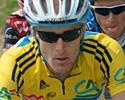
|
With Armstrong's retirement, things were wide open again. Leipheimer came out on top at the Dauphiné and won with a 1'48" lead. He took the lead on the fourth stage when he finished third on Mont Ventoux and picked up more time on the mountainous sixth stage. However, he was unable to even break the top ten in the Tour de France, ultimately finishing 12th.
Second place went to Moreau, who finished in seventh at the Tour. Bernhard Kohl finished third, but was not selected for T-Mobile’s Tour team. José Azevedo led the Discovery Channel to finish fourth in the Dauphiné and 18th in La Grande Boucle. Mancebo finished fifth in the Dauphiné, but was not allowed to start the Tour, being named as a suspect in Operación Puerto.
The Tour de France was won in Paris that year by Floyd Landis, who had finished a dismal 60th in the Dauphiné, nearly an hour down. He eventually lost that Tour title, though, after testing positive for testosterone. The win was then award to Oscar Pereiro of Caisse d'Epargne, who had finished 14th in the Dauphiné. The second, third and fourth place Tour finishers – Andreas Klöden (T-Mobile), Carlos Sastre (CSC) and Cadel Evans (Davitamon-Lotto) – did not ride the earlier French race. Fifth place finisher Denis Menchov placed sixth overall in the Dauphiné.
Results: Dauphiné Libéré versus Tour de France
2007
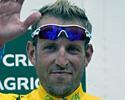
|
Christophe Moreau won the Dauphiné Libéré for the second time in 2007, although the race was dominated by Team Astana, which won four stages. He won the Mont Ventoux stage to move into second place behind Andrey Kashechkin (Astana), and took over the lead on the sixth stage, when Kashechkin was unable to answer the Frenchman's attacks. Moreau took his good form into the Tour, but a poor showing in the stage 13 time trial started him on the downward trend; he ended up 37th, over an hour and a half down on winner Contador.
Evans (Predictor-Lotto) was second in both the Dauphiné and the Tour. Kashechkin was third in the Dauphiné and was lying eighth when Astana withdrew.
The sixth place finisher in the Dauphiné, who finished 4'24" down, was able to do better in the Tour. Alberto Contador of Discovery Channel won that race following Michael Rasmussen's removal. Tour de France third place finisher Leipheimer was 24th in the Dauphiné and fifth placed Zubeldia was 19th. Sastre, who finished fourth in the Tour de France, did not ride the Dauphiné.
Results: Dauphiné Libéré versus Tour de France
Who will take victory in the 2008 Dauphiné Libéré, and what will be the relationship between his ride there and in the Tour de France? Stay tuned...
Photography
For a thumbnail gallery of these images, click here
Images by AFP Photo
- Alexander Vinokourov became a surprise winner in 1999.
- Tyler Hamilton taking yellow and Lance Armstrong playing the faithful lieutenant and finishing third in 2000
- France's Christophe Moreau (Festina) took the win from Pavel Tonkov (Mercury) by just one second in 2001
- USA's Lance Armstrong took his first Dauphiné win in 2000 over team-mate Floyd Landis.
- Lance Armstrong won in 2003 despite some serious pressure, primarily from second placed rider Iban Mayo.
- Iñigo Landaluze of Euskaltel-Euskadi was the surprise winner of the Dauphiné in 2005.
Images by Roberto Bettini/www.bettiniphoto.net
- Spain's Iban Mayo won in 2004 thanks largely to a resounding triumph on the slopes of the Mont Ventoux.
- USA's Levi Leipheimer turned up at the top of the Dauphiné in 2006.
- Christophe Moreau won the Dauphiné Libéré for the second time in 2007.
- The 2006 race, led by Spain's Alejandro Valverde, tops the Galibier.
